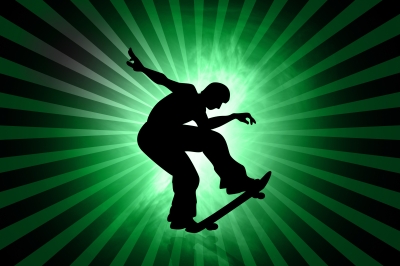How the Skateboarding World Has Transformed From What It Used to Be

Free image courtesy of FreeDigitalPhotos.net/By jscreationzs
Skateboarding appears as fresh-faced as some young women and men riding boards to school, the market, or local skate parks. What’s surprising to some, despite its popularity and association to exercise, is skateboarding’s age! The sport has been around since the 1960s.
Skateboarding, like those who mature, gain experience, and evolve, has transformed; the moves, direction, and riders look different today as compared to skateboarding’s beginnings.
The Beginning
It’s difficult for skate historians to attribute one event, invention, or person to the beginning of skateboarding; it seems multiple stories place the advent of skating around the same time. At some point, surfers, looking to replicate the experience on land (especially when waves were minimal), fused roller skates to a flat board, emulating the skating experience but with two (free) feet on one board.
Like surfing, the ‘new’ way of riding was considered alternative and ridiculous by most, yet a select few, enjoying the sensation of paving streets in style and speed, continued the practice. Despite athleticism of riders, the clay wheels, getting caught in cracks and sidewalks, often pitched riders off boards.
If smooth riding was an end goal, improvement was needed.
Failure to Launch
As more surfers and alternative athletes began crafting homemade boards, manufacturers like Hobie began producing boards. Moreover, the sport began to take hold on a national level hosting events and personalities like Torger Johnson. Despite the initial mainstream interest and devotion by some, skating began to regress in popularity.
By the end of the sixties, the fervor for the sport that had been building was just about gone. Yet, a select few manufacturers continued to sell boards to riders who remained dedicated to the sport.
Free Wheelin’
As quickly as a rider can carve in a new direction, skateboarding’s trajectory changed. Getting back to the wheels, urethane rather than clay, improved the speed, ability to turn and all-around safety of riders. Things were different this time.
Like eras of the sixties, the seventies hosted skate teams and events, such as the one taking place in Del Mar in 1975. To date, skate crews performed tricks on a flat square platform. Riders exhibited the origins of some of the tricks we see performed today as supplement to more advanced aerials and freestyle skating. The legendary Zephyr crew, with young riders who are now historic to skating, Jay Adams, Stacey Peralta, and Tony Alva, did not skate like other teams; and, that year, the world found out.
The true pioneers featured intimations that were performed and mastered decades later; riders of the Zephyr crew not only showed mastery of the platform, but many team riders committed to aerials and other alternative moves for their time.
The Duck Grows to a Swan
The 80’s and 90’s continued to show respect and new possibilities for the sport of skateboarding. Following in the footsteps of the Zephyr crew and some business-minded riders like Tony Alva, a young kid in the eighties, Tony Hawk, began skating with his own team, eventually carving his name in circles in skating’s history.
Stacey Peralta’s ‘Bones Brigade’ included Tony Hawk, Lance Mountain, Rodney Mullen, and other legends. The growth (and acceptance) of skate parks by the mainstream increased the sport’s popularity. Skating was no longer an ‘alternative’ sport; by the nineties, kids in cities, suburbs, and rural areas were boarding.
Adding to the sport’s allure were televised events, movies, and apparel made for skate fans, like the skate apparel at the Black Sheep Store. The X Games featured some of skating’s most-skillful personalities. Perhaps one of the most memorable events of the nineties (and the entire sport) took place on July 27, 1999. Tony Hawk, the sport’s biggest advocate and face man, became the first skater to ever successfully land a ‘900,’ using built momentum within a half pipe to elevate above the lip, turn three times in mid air and land back in the transition.
Skating 2K
Skateboarding’s popularity has not waned since the sixties. Personalities of the sport, innovations associated to boards, events, and an endless bag of tricks and radical sentiments fuels the sport forward. In addition to the X Games, some think skating should be included in the Olympics, considering the inclusion and popularity of its cousin, snowboarding.
It will be interesting to see what the future has to offer the sport of skating. Regardless, nothing can take away the sport’s history, integral events and inventions, and the personalities and radical sentiments that made it a possibility to easily find riders in just about any city in the nation and world.
Paul Harrison practically has his board attached to him. After years of supervising an after school skatepark program, he enjoys writing about the history and current trends of the sports. Keep on top of the latest skateboarding news on Facebook.
Related Posts
Posted in: Lifestyle, Recreation
Tags: skateboarding, X Games





